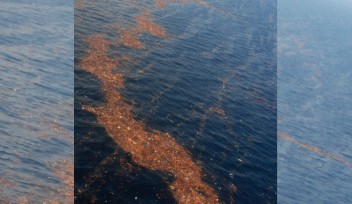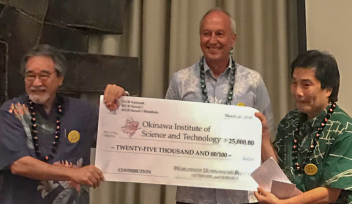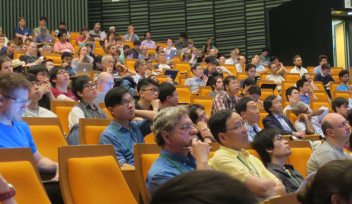Conference of the Universe Comes to OIST

OIST has offered its conference facilities to host various academic conferences and workshops. Today on June 10, the 500-seater OIST auditorium, which was completed in May 2012, opened its doors to the first major international conference, “The International Conference on Cosmic Microwave Background.” The conference will run until June 14.
One of the benefits of having a university in a community is the venue that it provides for international researchers who are engaged in exciting projects to gather and exchange current scientific knowledge and methodologies.
For researchers, these gatherings will provide an opportunity to step away from their daily environments in order to see their work from a different perspective, and to exchange opinions with researchers from around the world who are working in the same field. Such opportunities sometimes lead to major breakthroughs using completely new research approaches.
The universe is believed to have expanded from an almost invisibly small volume at extremely high temperature and energy, to its current vast size, as a result of a tremendous explosion called the Big Bang about 13.7 billion years ago. At that time, the enormous photon energy that filled the universe diminished steadily as the temperature dropped, releasing microwave radiation in every direction. Those microwaves still bathe the earth. Cosmic background radiation, discovered in 1965 by Arno Penzias and Robert Wilson of Bell Labs, is regarded as evidence that the universe began with the Big Bang.
As observation technology improved, researchers started to think that by further studying cosmic background radiation, they should be able for the first time, to directly observe traces of the initial phenomena of the Big Bang. Co-organizer of the conference, Professor Masashi Hazumi of the High Energy Accelerator Research Organization (KEK), says, “I believe that closely studying cosmic microwave background radiation will lead to an understanding of the role of gravity in the early universe before the Hot Big Bang. Research projects to study cosmic microwave background radiation are ongoing at various locations around the world, including the highlands of the Atacama Desert in Chile, and by using the Planck satellite, the WMAP satellite and next-generation satellites. I expect that new ideas that will contribute to such research projects will emerge here in Okinawa.”
Participating in this conference are some of the world's leading researchers, including Katsuhiko Sato, President of the National Institute of Natural Sciences, Eiichiro Komatsu, Director of the Max Planck Institute for Astrophysics, and experts on the Planck satellite, the WMAP satellite, and balloon experiments.
Jonathan Dorfan, President of OIST greeted the participants saying that “It is our pleasure to welcome outstanding scientists from around the world to participate in this conference. As a scientist myself who was involved in particle physics and accelerator research at Stanford University, I have a strong interest in the topics that will be discussed. OIST is a graduate university that is forging a new model for research and education. The University has no departments. Equipment and workspaces are shared, and offices are not grouped by field of specialization, thus facilitating interdisciplinary research opportunities by encouraging researchers and students of various backgrounds to interact. I hope you will be able to grasp these features in your campus tour and during your stay. Welcome to Okinawa and to OIST Graduate University.”
For press enquiries:
Press Inquiry Form

















